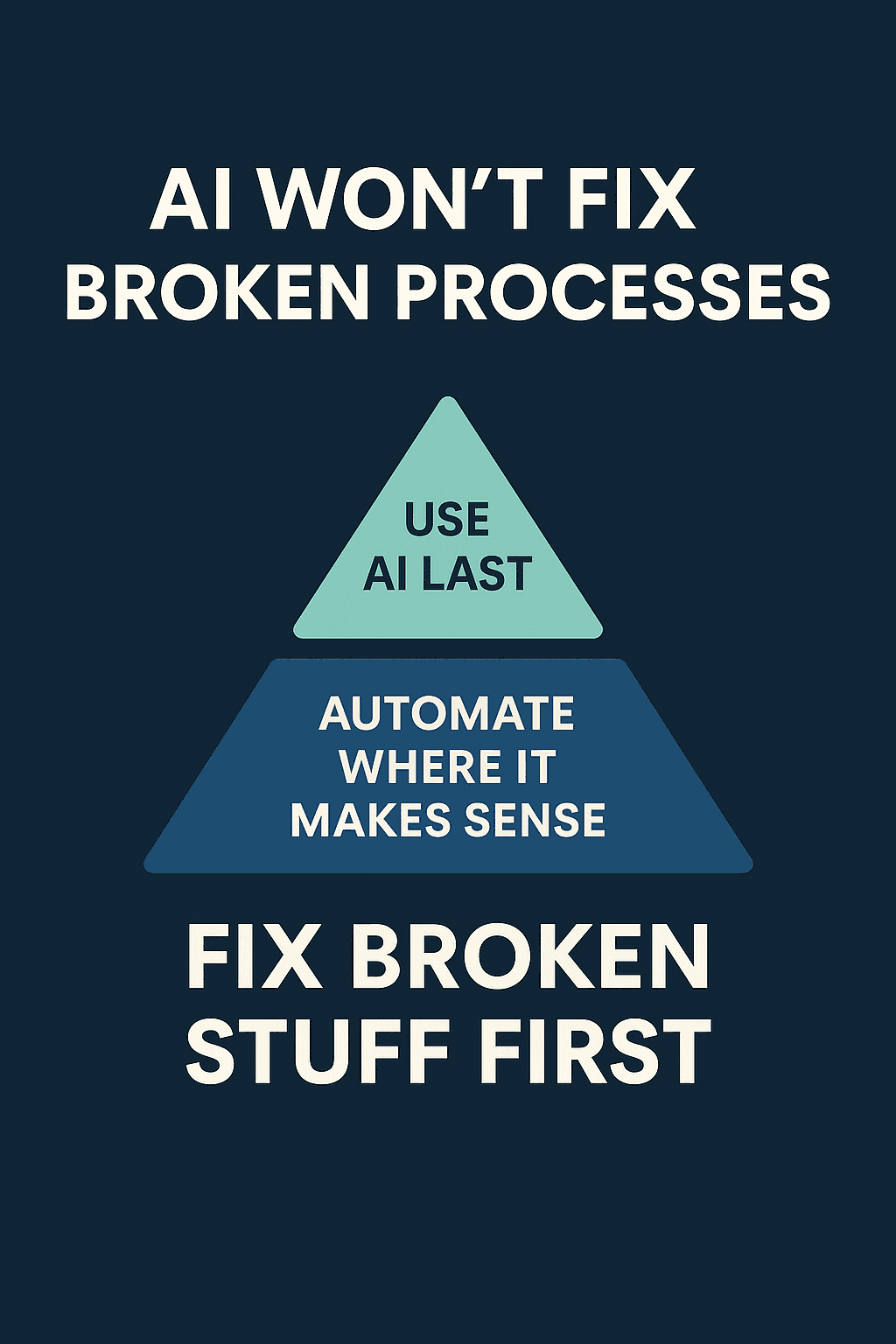AI Won’t Fix Broken Processes
AI Won’t Fix Broken Processes
Right now, “AI” has become the default answer to almost every business challenge. Struggling with billing? Deploy AI. Customer complaints piling up? Build an AI chatbot. Sales flat? Maybe AI can fix it.
It sounds promising, but here’s the uncomfortable truth: AI won’t save a broken process.
If your operations are already a mess, adding AI isn’t going to transform them. In fact, it often makes things worse—faster, louder, and more expensive.

Rocket Fuel in a Leaky Tank
Think about it this way: pouring rocket fuel into a leaky tank doesn’t get you to orbit—it just burns money and leaves you stranded.
That’s exactly what happens when companies throw AI at broken workflows. Automating bad processes doesn’t create efficiency—it just scales dysfunction.
At our company, for example, we rely on an old legacy system called ImageRight for workflow management. Every time a quote was created in our platform, an ImageRight task had to be generated. Whenever there was additional communication with an agent or we sold a policy, staff had to manually upload the policy and communication into ImageRight.
Instead of layering AI on top of this inefficiency, we fixed the foundation first. By simply using APIs to place the files directly into the appropriate workflow, we eliminated the manual steps. This straightforward but powerful automation saved us the work of several offshore staff members. No AI required—just fixing the process with the right automation.

Where AI Fails
Here are some common traps companies fall into:
- Automating chaos. Instead of fixing a flawed billing or claims process, companies rush to “AI-ify” it. The result? Faster errors, not better outcomes.
- Replacing instead of augmenting. Many assume AI can replace underperforming staff. The reality is AI doesn’t turn poor performers into great ones. It just exposes weaknesses more quickly.
- Mistaking novelty for progress. Launching a chatbot or plugging AI into your CRM may look innovative, but success depends on the experience. If customers struggle with it, that’s not progress—it’s frustration. But when chat is seamless, supportive, backed by real data, and built on solid processes, it reduces friction and truly elevates the customer journey.

Where AI Works
That doesn’t mean AI is useless. Far from it. When paired with strong operations, AI can create real breakthroughs.
The difference between success and failure usually comes down to three principles:
1. Fix Broken Stuff First: Before you automate, simplify. Map your processes, find the friction, and fix it manually. Once you have a clean workflow, then decide if automation or AI makes sense.
Often, you’ll uncover huge gains without touching AI at all. But when you do add it, the impact compounds.
2. Make Winners Win Bigger: Don’t waste AI trying to drag up your bottom 20%. Instead, give your best people superpowers. Imagine your top sales reps instantly getting better leads, or your best underwriters instantly classifying risks. That’s where AI shines—amplifying excellence.
3. Good AI Is Invisible: The best AI doesn’t announce itself. It works quietly in the background, making processes smoother and experiences easier—without adding friction or drawing attention.
In our own platform, for example, we use signature detection. When an agent uploads an application, AI automatically checks if all required signatures are present. The agent doesn’t need to click anything or even know the AI is there—it just works.
The impact is huge: fewer back-and-forth requests, faster policy processing, and a cleaner experience for everyone involved.
That’s what real innovation looks like. Not flashy tools customers resent, but invisible improvements that make the work feel effortless.

The Brutal Truth
The success of AI isn’t about how much you spend, or how many projects you launch. It’s about timing and fit.
Most AI failures come from companies trying to use technology as a shortcut for fixing deep operational problems. But technology isn’t strategy. And AI isn’t magic.
It’s leverage. And leverage only works when the thing you’re lifting is structurally sound.

The Question Every Leader Should Ask
Before you invest in another AI initiative, stop and ask:
👉 Which broken process are we trying to “AI” our way out of?
If the answer is yes, don’t move forward. Fix the process first. Then—and only then—layer AI on top.
Because AI doesn’t fix stupid. But when used wisely, it can accelerate smart.